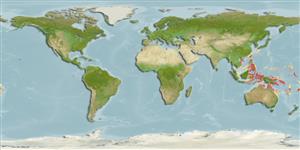Classification / Names
Common names from other countries
Main reference
Size / Weight / Age
Max length : 8.6 cm TL male/unsexed; (Ref. 90102)
Environment
Marine; reef-associated; depth range 2 - 12 m (Ref. 90102)
Climate / Range
Subtropical, preferred ?
Distribution
Western Pacific: Brunei, Indonesia, Philippines and Papua New Guinea (Ref. 90102); including Australia (Ref. 94127)..
Countries | FAO areas | Ecosystems | Occurrences | Introductions
Short description
Dorsal
spines
(total): 8;
Dorsal
soft rays
(total): 9;
Anal
spines: 2;
Anal
soft rays: 14 - 19. Colour pale pinkish grey with black band under the eye; a large black spot above upper posterior edge of opercle; numerous narrow orange bars on side. Differs from T. biguttata in lacking the spot on the caudal-fin base and having a diffuse dark bar directly below the large spot above the gill cover (Ref. 90102).
IUCN Red List Status (Ref. 115185)
Threat to humans
Harmless
Human uses
More information
Common namesSynonymsMetabolismPredatorsEcotoxicologyReproductionMaturitySpawningFecundityEggsEgg development
Age/SizeGrowthLength-weightLength-lengthLength-frequenciesMorphometricsMorphologyLarvaeLarval dynamicsRecruitmentAbundance
ReferencesAquacultureAquaculture profileStrainsGeneticsAllele frequenciesHeritabilityDiseasesProcessingMass conversion
Tools
Special reports
Download XML
Internet sources
Estimates of some properties based on models
Phylogenetic diversity index
PD50 = 0.5001 many relatives (e.g. carps) 0.5 - 2.0 few relatives (e.g. lungfishes)
Trophic Level
3.5 ±0.5 se; Based on size and trophs of closest relatives
Resilience
High, minimum population doubling time less than 15 months (Preliminary K or Fecundity.)
Vulnerability
Low vulnerability (10 of 100)
Price category
